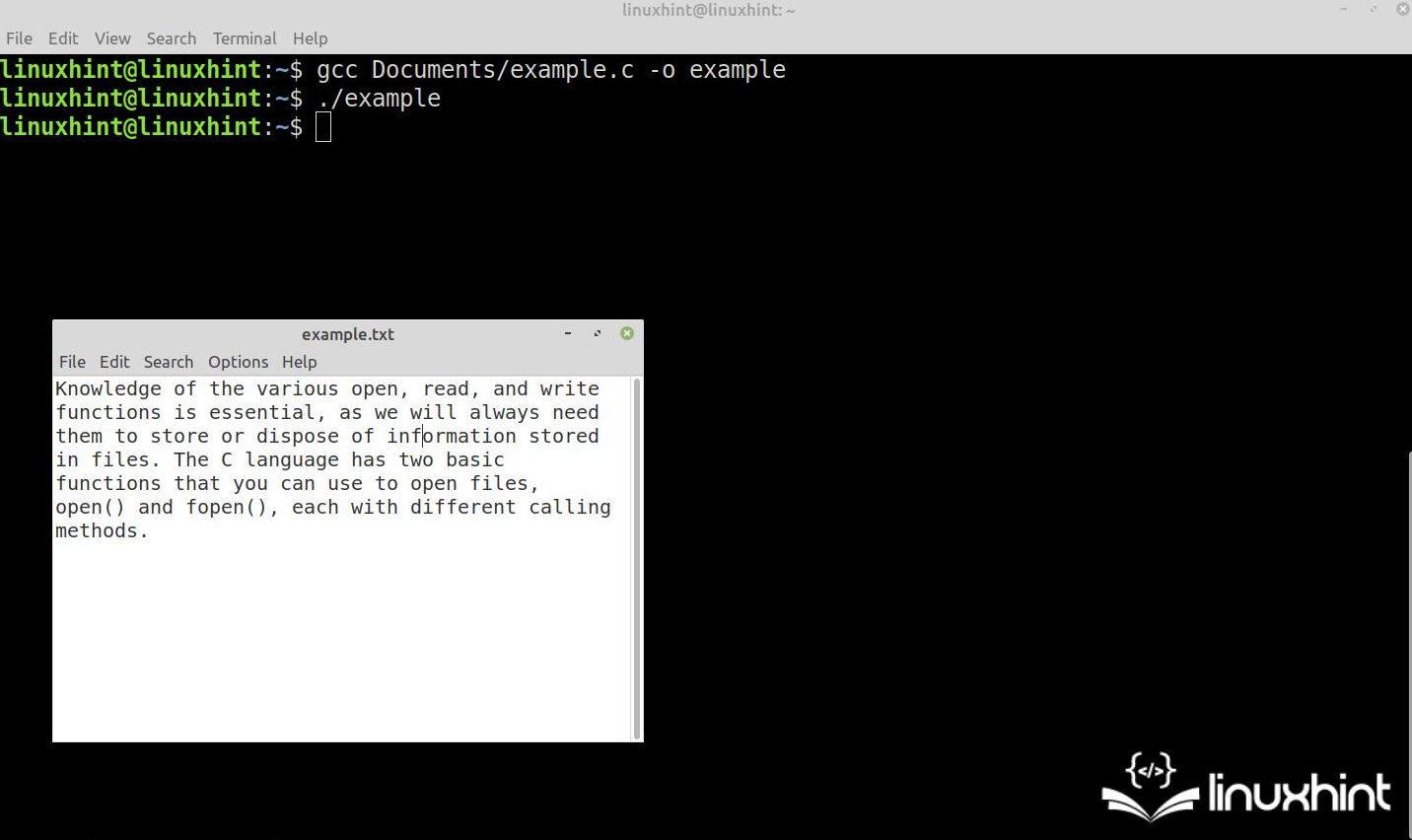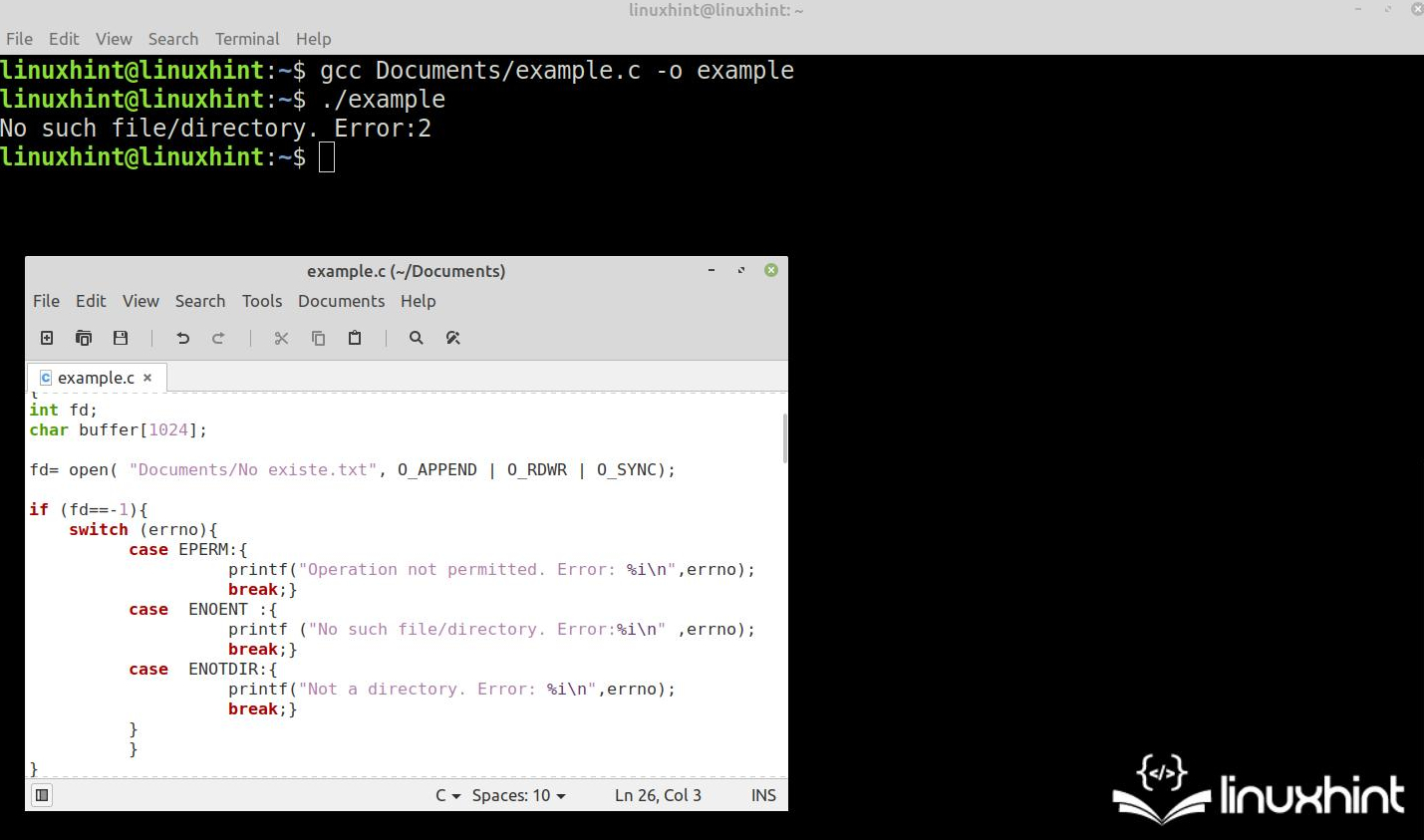Knowledge of the open, read, and write functions is essential because we always need them to store or dispose of the information that is stored in files. The C language has two basic functions which you can use to open the files, using the open() and fopen() functions, each with different calling methods.
In this Linux Hint article, you will learn how to use the open() function. We will explain everything about this function, its syntax, the method call, the input and output arguments, the type of data that it accepts in each case, and how to declare it properly.
Then, we’ll apply what we learned by implementing the use of this function in practical examples that we prepared for you with code snippets and images that show the use of the open() function in the C language.
In order for you to have a comprehensive knowledge, we add a special section that describes all the errors that can occur when using this function, as well as their detection and identification, so that in case they occur, you have the necessary techniques for a quick solution.
Syntax of the Open() Function in C Language
Description of the Open() Function in C Language
The open() function opens a file for reading or writing. This function opens the file that is specified in the pathname input argument. This input must specify the absolute or relative path and the name of the file in string format or a pointer to it.
The flags input argument specifies the attributes that the file must have. The following is a list of the flags that this input argument accepts, and a brief description of the attribute that each one sets:
| Flag | Description |
| O_RDONLY | Open file for reading only. |
| O_WRONLY | Open file for writing only. |
| O_RDWR | Open file for reading and writing. |
| O_CREAT | Creates a file in the path and name specified in pathname argument. |
| O_ APPEND | Opens the file and places the cursor at the end of the contents. |
| O_ASYNC | Enable input and output control by signal. |
| O_CLOEXEC | Enable close-on-exec mode on the open file. |
| O_NONBLOCK | Disables blocking of the file opened. |
| O_TMPFILE | Create an unnamed temporary file at the specified path. |
In cases where more than one flag is used, a logical “OR” operation must be performed between them. This can be done within the input argument flags in the same line of code as the function call.
The attributes and modes can be changed or consulted once the file is opened with the fcntl() function.
The open() function returns an integer which contains the descriptor of the opened file. This descriptor is used as an input argument for file processing functions like read(), write(), etc., to refer to the file.
This function is defined in the “unistd.h” header. The flags that define the attributes and mode to open the file are defined in “fcntl.h”. To use the open() function, you must include these headers in your code as follows:
#include <fcntl.h>
How to Open a File Using the Open() Function in C Language
In this example, we will use the open() function to open a file in read and write mode. In this case, it is a previously created file called “example.txt” which is stored in “Documents”.
Step 1: The first step is to include the required headers and declare that it exits empty and return in the main() function.
Step 2: The next step is to declare the variables that serve as input and output arguments to the open() function. As output argument, we declare the “fd” integer which is the file descriptor. As input argument, we declare the buffer character array which contains the string with the path and name of the file to be opened.
We also declare an array of 512 characters called “text” where we store the text that we want to write to the file which, in this case, is the first paragraph of this article.
Step 3: Once the variables are declared, we call the open() function and pass the “fd” integer as the output argument, the string path as the first input argument, and the O_WRONLY flag as the second argument.
Step 4: When open() returns from the call, it returns the descriptor of the file which is opened in “fd”. Then, we write with the write() function, passing the “fd” descriptor as the first input argument, the string text as the second input argument, and finally the size of the text which is obtained with the strlen() function. After the write operation, we close the file with the close() function.
Here is the complete code for this example:
#include <stdlib.h>
#include <stdio.h>
#include <unistd.h>
#include <fcntl.h>
#include <string.h>
void main ()
{
//Step 2
intfd;
char buffer[]= "Documents/example.txt";
char text[512] ="Knowledge of the various open, read, and write functions is essential because we will always need them to store or dispose of information stored in files.
The C language has two basic functions you can use to open files, open() and fopen(), each with different calling methods.";
//Step 3
fd= open(buffer, O_WRONLY);
//Step 4
write( fd, &text, strlen(text));
close( fd );
}
The following figure shows the compilation and execution of this code along with the file that we just wrote. As we can see, the open() function opens the file correctly. We then use the write() function to write the contents of the text. In this case, it contains the first paragraph of this article:
Errors that Can Occur When Using the Open() Function: How to Detect and Identify Them
Using the open() function can lead to various errors. If this is the case, it returns a result that is equal to -1.
The easiest way to determine if an error has occurred is to use an “if” condition where the condition is the -1 value which is returned in “fd”. Now, let us look at how you can use this method to determine if an error has occurred:
if ( fd==-1){
printf ("An error occurred while trying to open file.");
}
If the open() function returns with an error, it goes to the “if” statement and prints the message, “An error occurred while trying to open file“.
When open() returns a result that is equal to -1, it automatically stores a numeric code in the errno global variable which is defined in the “errno.h” header. This numeric code can be used to identify the error that occurred.
The following is an excerpt of the errors that the open() function can generate, along with a brief description of each error and the associated integer value:
| Definition | Value in errno | Error |
| EPERM | 1 | Operation not permitted |
| ENOENT | 2 | No such file or directory |
| EINTR | 4 | Interrupted system call |
| ENXIO | 6 | No such device or address |
| ENOMEM | 12 | Out of memory |
| EACCES | 13 | Permission denied |
| EFAULT | 14 | Bad address |
| EBUSY | 16 | Device or resource busy |
| EEXIST | 17 | File exists |
| ENODEV | 19 | No such device |
| ENOTDIR | 20 | Not a directory |
| EISDIR | 21 | Is a directory |
| EINVAL | 22 | Invalid argument |
| EFILE | 23 | File table overflow |
| EMFILE | 24 | Too many open files |
| ETXTBSY | 26 | Text file busy |
| ENOSPC | 28 | No space left on device |
| EROFS | 30 | Read-only file system |
| ENAMETOOLONG | 36 | File name too long |
| ELOOP | 40 | Too many symbolic links encountered |
| EOVERFLOW | 75 | Value too large for defined data type |
| EDQUOT | 122 | Quota exceeded |
The easiest way to identify an error is to open a switch where the errno variable is the jump condition and each case is an error definition.
Next, consider an example where we open a file that does not exist, resulting in an error. To detect an error, we use the “if” condition that we saw in the previous snippet. To identify it, we open a switch with the three most common errors that this function can produce:
#include <unistd.h>
#include <fcntl.h>
#include <errno.h>
void main ()
{
intfd;
char buffer[1024];
fd= open( "Documents/No existe.txt", O_APPEND | O_RDWR);
if (fd==-1){
switch (errno){
case EPERM:{
printf("Operation not permitted. Error: %i\n",errno);
break;}
case ENOENT :{
printf ("No such file/directory. Error:%i\n" ,errno);
break;}
case ENOTDIR:{
printf("Not a directory. Error: %i\n",errno);
break;}
}
}
}
The following image shows the compilation and execution of this code. In it, we see how the generated error is detected in the “if” condition and how the errors are identified in the switch conditional to display the message and specific value:
Conclusion
In this Linux Hint article, we explained how to use the open() function to open the files.
We showed you the syntax of this function and the theoretical description of how it works, the call method, the input arguments, and the data type that is used in each case.
We then implemented the use of the open() function in a practical example using code snippets and images. We showed you how to declare the required variables, call this function to open a file, and write to it.
We also included a section where we list all the errors that this function can generate. We showed you the techniques to detect and classify them so that you have the necessary means to quickly fix them when they occur.


